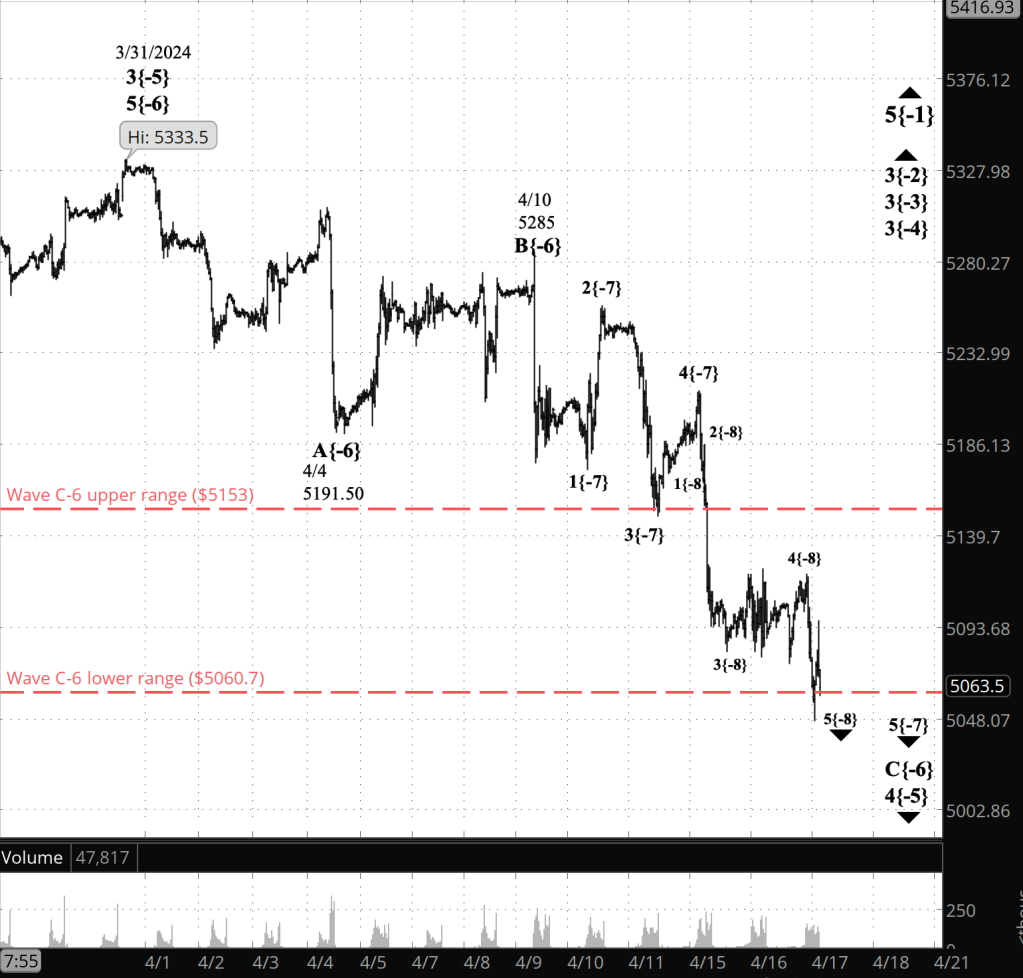3:30 p.m. New York time
Half an hour before the closing bell. The price movement overnight and during the session has clarified the count within the final subwave, wave C, of the 4th-wave downward correction that began on March 31. In the discussion that follows I’ll use the labeling system that appears on the chart, with the wave number followed by a subscript in curly brackets that indicate how many degrees removed from Elliott Wave Theory’s Intermediate degree.
Elliott Wave Theory, when applied to a closer view of the chart shows that wave C{-6} is in its 5th and final subwave — wave 5{-7} on the chart — which in turn is in its final subwave — wave 5{-8}. It’s not marked on the chart, but wave 5{-8} has completed its second subwave — wave 2{-9} — and has begun the middle subwave — wave 3{-9}.
Waves of the {-9} degree can begin and end within a day, so at that level things are happening fast. The final wave of the 4th wave downward correction is likely within days of reaching its end.
I’ve updated the chart.
9:35 a.m. New York time
What’s happening now? The S&P 500 E-mini futures continued its bottom fishing overnight, dropping into the 5070s, with each lower low potentially being the end of the decline that began on March 31 and the beginning of an equally significant rise.
What does it mean? According to Elliott Wave Theory, the decline is a 4th-wave downward correction, and it is in the final stage of its 3rd and final subwave, wave C. When wave C is complete, it will also be the end of the 4th-wave correction and the beginning of a 5th-wave uptrend.
The correction is taking the form of a Flat, and typically wave C of that sort of correction will travel somewhere between the length of the preceding wave A and 1.65 times that length. The A-wave had a length of 142. Wave C began from 5285. So typically, wave C will end somewhere between 5153 and 5060.70.
The overnight low is well below the upper boundary of the price target range and is only 10 points above the lower boundary. I’ve marked the boundaries of the target price range on the chart with red dashed lines.
What are the alternatives? The 20th-century New York Yankees baseball team catcher Yogi Berra famously said, “It ain’t over till it’s over.” The principal analysis today says, “It ain’t over.” The alternative analysis says, “It’s over.” It’s a typical ambiguity when a wave reaches its bottom-fishing stage.

[S&P 500 E-mini futures at 3:30 p.m., 100-minute bars, with volume]
What does Elliott wave theory say? Here are the waves that underly the analyses.
Principal Analysis:
- Rising wave 5{0} is underway. It is a wave of Intermediate Degree that began in December 2018.
- It is in its final subwave, wave 5{-1}
- Within wave 5{-1}, rising waves 3{-2}, 3{-3} and 3{-4} are underway, as is the smallest wave labeled on the chart, wave 3{-5}.
- Downtrending wave 4{-5} is in its final subwave, falling wave C{-6}, which is in its last subwave, falling wave 5{-7}
Reading the chart. Price movements — waves – – in Elliott wave analysis are labeled with numbers within trending waves and letters with corrective waves. The subscripts — numbers in curly brackets — designate the wave’s degree, which, in Elliott wave analysis, means the relative position of a wave within the larger and smaller structures that make up the chart. R.N. Elliott, who in the 1930s developed the form of analysis that bears his name, viewed the chart as a complex structure of smaller waves nested within larger waves, which in turn are nested within still larger waves. In mathematics it’s called a fractal structure, where at every scale the pattern is similar to the others.
Learning and other resources. Elliott wave analysis provides context, not prophecy. As the 20th century semanticist Alfred Korzybski put it in his book Science and Sanity (1933), “The map is not the territory … The only usefulness of a map depends on similarity of structure between the empirical world and the map.” And I would add, in the ever-changing markets, we can judge that similarity of structure only after the fact.
See the menu page Analytical Methods for a rundown on where to go for information on Elliott wave analysis.
By Tim Bovee, Portland, Oregon, April 17, 2024
Disclaimer
Tim Bovee, Private Trader tracks the analysis and trades of a private trader for his own accounts. Nothing in this blog constitutes a recommendation to buy or sell stocks, options or any other financial instrument. The only purpose of this blog is to provide education and entertainment.
No trader is ever 100 percent successful in his or her trades. Trading in the stock and option markets is risky and uncertain. Each trader must make trading decisions for his or her own account, and take responsibility for the consequences.
All content on Tim Bovee, Private Trader by Timothy K. Bovee is licensed under a Creative Commons Attribution-ShareAlike 4.0 International License.
Based on a work at www.timbovee.com.

You must be logged in to post a comment.